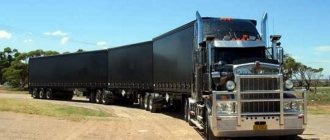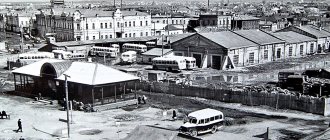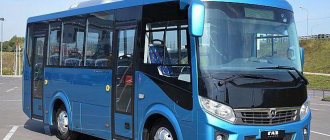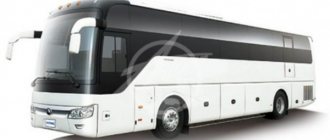How much does a car weigh on average?
Thus, it turns out that if we take, so to speak, “in general for the hospital,” then the average weight of a passenger car is approximately from 1 to 1.5 tons, and if we talk about SUVs, then the whole weight already shifts from 1.7 tons to 2. 5 tons.
Interesting materials:
What cities are there in Korea? What cities are there in Latvia? What cities are there in North Ossetia? What films were filmed in the city of Nizhny Novgorod? Which cities in Belarus border on Lithuania? Which cities were bombed on June 22? What cities were founded by Yuri Dolgoruky? What cities were built in Siberia in the 16th and 17th centuries? What cities are there near Yekaterinburg? What cities are near Khabarovsk?
MAZ-107
The MAZ-107 low-floor bus is a vehicle for urban passenger transportation. The main distinguishing characteristic of the bus is its particularly large capacity.
Design features of the MAZ-107
MAZ-107 has a durable all-metal body made using German technology.
The bus is equipped with an automatic transmission, a powerful Mercedes-Benz OM 906LA engine located in the rear overhang of the engine compartment, and a spacious fuel tank with a capacity of 220 liters.
The differential lock allows the MAZ bus to easily move away on ice or compacted slippery snow. The bus has a steering rear axle, which makes it possible to reduce the turning radius and increase maneuverability on narrow city streets.
Ergonomics of MAZ-107
The MAZ bus can accommodate 154 people. The main advantages of this passenger equipment also include reduced operating costs and the absence of vulnerable joints. The vehicle is characterized by increased convenience for passengers (boarding and disembarking) because it has a low floor. This design solution indirectly makes it possible to reduce the time spent on stops. The number of seats varies from 25 to 31.
In the MAZ cabin, separate seats are arranged in 2 rows: on the left side - double, on the right - single. To allow people with disabilities to use the bus, it has a folding ramp. The MAZ-107 interior is equipped with fastenings and devices to accommodate one wheelchair.
The driver's cabin is equipped with an independent air heater (2-2.2 kW), an adjustable pneumatic seat and other equipment for comfortable work.
Equipment MAZ-107
- independent equipment for engine preheating and interior heating - liquid heater (30 kW, Webasto);
- independent air heater for the driver's cabin (2.0-2.2 kW, Eberspacher or Webasto);
- special tires (Belarus);
- anti-lock braking system ( ABS);
- anti-traction system ( ASR );
- forced body tilt system “Kneeling”;
- wear-resistant non-slip floor covering “Grabiol”;
- thermal insulating anti-noise ceiling covering;
- anti-corrosion coating on the bottom and in hidden cavities;
- galvanized sheet on the sides and roof;
- communication equipment (loudspeaker, amplifier and microphone);
- a folding ladder for a wheelchair and equipment for securing it in the cabin;
- glass with tinting and valve windows;
- 4 roof fans;
- on-demand stop buttons;
- adjustable driver's seat with air cushion (manufactured by MAZ OJSC);
- screw-in towing forks;
- a partition separating the salon from the driver's cabin, without access to the salon.
Source: https://www.MAZ-Rus.com/products/passenger_vehicle/maz-107/
The Ikarus 256 bus was mass-produced from 1977 to 2002 by the Hungarian automaker. The model was similar to the 250th. The only difference was its length, which was one meter less.
Compared to the previous modification, the 256th had more functional innovations, was more comfortable and met all the requirements of a tourist bus. It was mainly used as a means of transport between cities and as a bus for tourist routes.
Over the entire period of production, the Ikarus 256 was modified several times and supplemented with new equipment. So, based on the model, the following modifications were released: 256.21Н, 256.50, 256.51, 256.54, 256.74, 256.75.
Of course, at the moment, cars of the above modifications are inferior in terms of comfort to newer tourist buses, especially those produced abroad such as Neoplan, Scania, etc. But at that time it was the most popular vehicle for transporting passengers intercity and simply as a tourist and excursion bus. The use of the 256th model has become less relevant. But still it can often be seen on public roads.
The length of the bus is eleven meters, height - three meters and ten centimeters, width - two and a half meters. Wheelbase - 5330 mm, ground clearance - 350 mm. The front and rear overhangs are 2460 and 3180 mm, respectively.
The load-bearing body of the bus has a carriage-type layout and is made in a square shape. The sides of the 256 are made by welding metal sheets, which affects their strength. They are also easily repaired if deformed. The transport was equipped with stamped wheels, which were used on most domestic heavy-duty vehicles, and were therefore interchangeable. The Ikarus 256 bus was equipped with 280-radius wheels and 20-inch tires.
The power unit was installed in the rear of the body and was more powerful than that of similar modifications. During the modernization process, the volume of the luggage compartment was increased, in which fairly large items can be placed.
Exterior
As standard, the bus was painted red with a white stripe along the sides. Almost all modifications are very similar and are equipped with the same body parts.
These are voluminous metal bumpers with built-in fog lights, a narrow radiator grille with four round headlights. The Ikarus 256 is equipped with a viewing windshield with a central dividing partition.
The bus has two doors located in the front and rear parts of the body. The rear one opens manually, and the front one is equipped with a pneumatic drive.
Compared to other bus models, the Ikarus 256 is distinguished by its comfort and practicality. Ten rows of passenger seats and a five-passenger rear seat are installed on the so-called podium, which provides excellent visibility and additional convenience. Armchairs of a soft type, with reclining backs and armrests, with a high back.
As a rule, seat upholstery is made of durable fabrics and leatherettes, and for practicality, you can put covers on the chairs. When covering long distances, the passenger does not get tired, and also has the opportunity to change the position of his body. It is also possible to move the chair on a special slide, thereby changing the distance between passengers.
THIS IS INTERESTING: Types of minibuses
The issue of increasing usable space and increasing convenience was resolved by reducing the number of seats to forty-three. Attention was also paid to the passengers' feet - footrests with an adjustment function are mounted under the seats.
As in other modifications of the bus, in the 256 there is a compartment for small hand luggage above the seats, which allows you to free your comfort zone from various things needed on long trips.
The bus windows are equipped with curtains made of high-quality material, which allow protection from direct sunlight, since previously the windows in this type of transport did not have tinting.
Ventilation of the interior can be carried out either through hatches in the ceiling or forced. Above each pair of seats there are elements of individual ventilation and additional lighting of the passenger area.
Many long-distance buses are equipped with a TV, and the 256 model is no exception. This allows passengers to pass the time during a long journey. Take a look at the interior of the Ikarus 256 car. The photo below indicates that the bus is quite comfortable and convenient for long trips. At first glance, you can’t tell that the vehicle was designed and developed in the last century, and at the moment this bus can compete with more modern analogues.
Driver area
The driver's seat is designed as an open cab. All equipment in the driver's seat remains virtually unchanged, with the exception of minor additions and materials used. All controls and information instruments are located quite conveniently.
Everything is done to ensure that the driver feels no less comfortable than the people in the cabin, does not get overtired and can drive the vehicle for quite a long time.
A separate door for the driver is not provided for by the body design, so some of the equipment is located on the left side of the driver.
Engine: “Ikarus 256”
This bus is equipped with a Raba diesel engine D10 UTSLL - 155,P6 TD (bridge of the same company). The engine has six cylinders and develops a power of two hundred and ten horsepower. The engine is opposed. The volume of the power plant is 10350 cm3, and the maximum torque is 883 Nm.
The highest speed that a bus with this unit can reach is one hundred and twenty kilometers. And with a maximum filling capacity of 300 liters of diesel, the car can cover a distance of up to one thousand kilometers. At the same time, the fuel consumption of the Ikarus 256 in highway conditions is 33 liters per 100 kilometers in suburban mode.
Transmission and chassis
Paired with a two-hundred-horsepower engine is a six-speed manual transmission ZF-S6-90U, which provides good dynamic performance. The rear axle suspension is of a dependent type, mounted on four pneumatic springs with two longitudinal reaction rods and two A-type rods. Four shock absorbers are installed. The front axle suspension is of a dependent type, installed on two pneumatic springs with two longitudinal reaction rods and two shock absorbers.
All modifications of Ikarus 256 buses are equipped with this suspension system. The suspension scheme of this type ensures a smooth and soft ride of the bus, stably keeps it from strong roll and swaying of the body when overcoming sharp turns and slopes.
You get the feeling that you are riding on board some cruise ship that is being rocked by the waves. Even after 40 years of operation, the suspension of this car remains the same smooth and reliable. The build quality here is top notch.
As they say, cars used to be made “to last forever.”
The total curb weight of the bus is 10,400 kilograms, the total weight is sixteen tons. In this case, the permissible load on the front axle is 6500 kg, and on the rear axle - 11000 kg. The number of seats is 43 plus an additional seat for the driver's partner. The useful volume of the luggage compartment is 3.8 cubic meters.
Electrical equipment of the Ikarus 256 bus
The technical characteristics of electrical equipment and equipment have the following indicators. The operating voltage of the on-board network is twenty-four volts. The machine is equipped with 2 batteries with a capacity of 182 ampere-hours.
The power is turned on by connecting the ground to the button near the front bumper. The engine is equipped with an AVF VG901 generator, which generates 75 amperes and 28 volts of voltage. The engine is started by the AVF IV522 starter. Its power is 5.4 kW.
THIS IS INTERESTING: Comfortable minibus
The fuse box is located in the driver's cab.
Summary of the review
In general, the bus of the Hungarian company has good characteristics and is highly reliable. Despite the emergence of new developments in this class of buses, the old Ikarus remains on the competitive line and is still widely used.
Here is another fact that speaks of the popularity of the Ikarus 256 model. “Omsi” is a simulation game in which anyone can try themselves as a driver of a tourist, excursion or regular bus.
This project also uses an exact copy of the brainchild of the Hungarian manufacturers in question.
So, we found out what technical characteristics, interior and exterior the Ikarus 256 bus has.
Source: https://FB.ru/article/235404/ikarus-tehnicheskie-harakteristiki-rashod-topliva-i-foto
Filling volumes and recommended operating materials PAZ 3205
Fuel tank: PAZ-3205 - 105 l; PAZ-3206 - 150l, gasoline A-76; cooling system - 25l, water or antifreeze A-40; engine lubrication system - 10 l, all-season M-8B, or M6/10B, winter ASZp-6; steering gear housing 1.5 l, TAP-15V; power steering system - 3.2 l, all-season oil grade P, substitutes: turbine grade T in summer, spindle AU in winter; gearbox - Zl, TAP-15V or TSp-15K; transfer case - 1.5 l, TAP-15V or TSp-15K; rear axle housing - 8.2 l, TSp-14gip; front axle housing - 7.7 l, TSp-14GIP; hydraulic brake and clutch drive system - 1.47 l, Tom brake fluid; shock absorbers - 4×0.475 l, AZh-12T; windshield washer reservoir - 2 l, NIISS-4 liquid mixed with water; brake system freeze guard - 0.2 l, industrial alcohol.
Weight of units (in kg) Engine with equipment and clutch - 304,
cardan shafts: PAZ-3205-27, PAZ-3206-41.5,
gearbox - 56, transfer case - 48.5,
front axle: PAZ-3205 - 195; PAZ-3206 - 365,
rear axle - 270, body - 2100, wheel and tire assembly - 80, radiator - 18.5.
PAZ 3205 is equipped with different types of domestic and foreign gasoline engines. The new modifications achieve fuel savings of 2-3 liters per 100 km. The total fuel consumption of new modifications of the bus is 18 liters if the equipment operates in a mixed cycle. In the urban cycle, consumption is 20.5 liters. The capacity of the standard fuel tank is enough for a trip of 500 kilometers without the need for intermediate refueling.
The bus has a pneumatic braking system. Some modifications are marked by the presence of a pneumatic-hydraulic braking system equipped with dual-circuit ABS. The PAZ 3205 is controlled by the MAZ 64229 steering system with a standard hydraulic booster. At the same time, a fully loaded bus can reach a speed of 100-120 kilometers per hour.
Technical description PAZ 3205
Engine. Maud. ZMZ-672-11, gasoline, V-shape. (900), 8 cyl., 92.x80 mm, 4.25 l, compression ratio 7.6, operating order 1-5-4-2-6-3-7-8; power 88.3 kW (120 hp) at 3200-3400 rpm; torque 284.5 Nm (29 kgf-m) at 2000-2500 rpm; carburetor K-135; inertia-oil air filter.
Transmission. The clutch is single-plate, the release drive is hydraulic. Gearbox 4-speed, gear. numbers: I-6.65; II-3.09; III-1.71; IV-1.00; ZH-7.77; synchronizers - in 3rd and 4th gears. Transfer case (for PAZ-3206) 2-speed. transmit. numbers: 1-1,963; 11-1.00. Cardan transmission: for PAZ-3205 it consists of two shafts with an intermediate support; PAZ-3206 has three cardan drives: from the engine to the transfer case and from the transfer case to the axles. Main gear - single, hypoid, gear. number 6.83.
Pontiac V8
Pontiac V8 Serie 302 (Pontiac V8 Series 302 Engine) is a full-size car produced by Pontiac in 1932. its debut on December 22, 1931, sales began rapidly within 3 months. The model was based on the 1931 Oakland Series 301 (Oakland Series 301 1931) model year and was only slightly modified from the original, which was discontinued due to the cancellation of the Oakland brand. V8 (Auckland V8) were an addition to the already produced Serie 402 (Series 402). The V8, as its name suggests, was powered by an eight-cylinder V-shaped 4.1-liter engine producing 85 horsepower in the Serie 402 (Series 402), the car was equipped with a three-speed manual transmission, but fully synchronized with a single-plate dry clutch, as well as a driveshaft on rear axle, but brakes were only on the rear wheels. Spicewine wheels. The wheelbase was 3 centimeters longer than the six-cylinder model. The models were similar to those produced by the Fisher 2- and 4-door sedan, 2-door coupe and convertible, and externally, however, the V8 "bird in flight" emblem on the front of the hood, while the Serie 402 (Series 402) was the coat of arms of the head of an Indian chief. 16 colors were offered for the painting. the hood had 4 doors on both sides for ventilation. V8 equipment included radio and heating. The following year the V8 model was replaced by the new Economy Eight model with the same engine. just 6,281 copies were released.
Vehicle recycling process
It is worth remembering that not the entire weight of the car will be taken into account when recycling. 30% will be deducted from the weight to account for non-metallic parts and contamination. This is standard practice for all processing facilities. It is also important to consider the average prices per kilogram of scrap metal in individual regions of residence. The fact is that in the central part of Russia recycling will be more profitable than in remote areas of the country.
Also, in order not to encounter scammers, you need to find out from friends, acquaintances, on the Internet, on official websites the variety of prices in the region and find out where it will be more profitable to dispose of the car.
Bus
A bus is a trackless motor vehicle, technically designed to carry nine or more passengers and capable of maneuvering on the road, powered by a source of energy or produced from fuel stored on board. Buses less than 5.5 m long are called minibuses according to the Russian classification - especially small class buses also include minibuses with a capacity of 9 to 16 passengers. They include minibuses Fiat Ducato (Fiat Ducato), Ford Transit (Ford Transit), IVEKO Daily (Iveco Daily), Gazelle, RAF-977, RAF-2203, as well as other cars of various brands. A bus length of 5.5 to 7.0 m is also known as a small van class. Bus lengths from 7.0 to 10.0 m are called middle class buses. They also include the hybrid minibus and medium-class bus IVEKO VSN700 (IVECO VSN700) and other buses with similar equipment. Bus lengths from 10.0 to 13.0 (M 13.0) are called large class buses. Buses longer than 13.0 (M 13.0) are called extra-large buses. These include the tremosnice site, and articulated buses.









